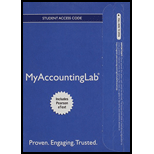
1.
Bonds: Bonds are long-term promissory notes that are represented by a company while borrowing money from investors to raise fund for financing the operations.
Bonds Payable: Bonds payable are referred to long-term debts of the business, issued to various lenders known as bondholders, generally in multiples of $1,000 per bond, to raise fund for financing the operations.
To prepare:
2.
To prepare: Journal entry to record semiannual interest and amortization of premium on bonds.
3.
To prepare: Journal entry to record semiannual interest and amortization of premium on bonds.
4.
To prepare: Journal entry to record the retirement of bond payable at maturity.
Want to see the full answer?
Check out a sample textbook solution
Chapter 12 Solutions
MyLab Accounting with Pearson eText -- Access Card -- for Horngren's Financial & Managerial Accounting, The Financial Chapters (My Accounting Lab)
- Chapter 18 Homework 8 1 points QS 18-4 (Algo) Measuring costs using high-low method LO P1 Saved The following information is available for a company's maintenance cost over the last seven months. 100 190 110 Month Units Produced eBook June July August September October November 200 230 Ask December Maintenance Cost $ 3,950 5,390 4,110 ETT 140 4,590 5,550 6,030 3,150 Print References Mc Graw Hill Using the high-low method, estimate both the fixed and variable components of its maintenance cost. High-Low method - Calculation of variable cost per unit produced Cost at highest volume - Cost at lowest volume Highest volume-Lowest volume Total cost at the highest volume Variable costs at highest volume: Highest volume Variable cost per unit produced Total variable costs at highest volume Total fixed costs Total cost at the lowest volume Variable costs at lowest volume: Lowest volume Variable cost per unit produced Total variable costs at lowest volume Total fixed costs 230 units $ 3,150.00…arrow_forwardneed this account subjects solutionarrow_forwardWhat is the earnings yield of a single share for this financial accounting question?arrow_forward
- can you please solve thisarrow_forwardIn 2024, Carson is claimed as a dependent on his parents' tax return. His parents report taxable income of $200,000 (married filing jointly). Carson's parents provided most of his support.What is Carson's tax liability for the year in each of the following alternative circumstances. Carson is 17 years old at year-end and earned $15,400 from his summer job and part-time job after school. This was his only source of income. What is his tax liability?arrow_forwardPlease provide answer this financial accounting questionarrow_forward
- Principles of Accounting Volume 1AccountingISBN:9781947172685Author:OpenStaxPublisher:OpenStax College
 Financial Accounting: The Impact on Decision Make...AccountingISBN:9781305654174Author:Gary A. Porter, Curtis L. NortonPublisher:Cengage Learning
Financial Accounting: The Impact on Decision Make...AccountingISBN:9781305654174Author:Gary A. Porter, Curtis L. NortonPublisher:Cengage Learning Cornerstones of Financial AccountingAccountingISBN:9781337690881Author:Jay Rich, Jeff JonesPublisher:Cengage Learning
Cornerstones of Financial AccountingAccountingISBN:9781337690881Author:Jay Rich, Jeff JonesPublisher:Cengage Learning  Excel Applications for Accounting PrinciplesAccountingISBN:9781111581565Author:Gaylord N. SmithPublisher:Cengage Learning
Excel Applications for Accounting PrinciplesAccountingISBN:9781111581565Author:Gaylord N. SmithPublisher:Cengage Learning College Accounting, Chapters 1-27AccountingISBN:9781337794756Author:HEINTZ, James A.Publisher:Cengage Learning,
College Accounting, Chapters 1-27AccountingISBN:9781337794756Author:HEINTZ, James A.Publisher:Cengage Learning, Financial AccountingAccountingISBN:9781305088436Author:Carl Warren, Jim Reeve, Jonathan DuchacPublisher:Cengage Learning
Financial AccountingAccountingISBN:9781305088436Author:Carl Warren, Jim Reeve, Jonathan DuchacPublisher:Cengage Learning





